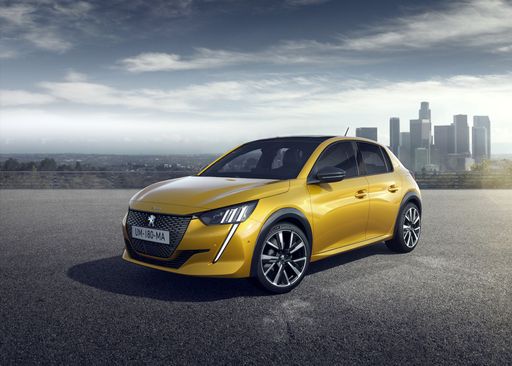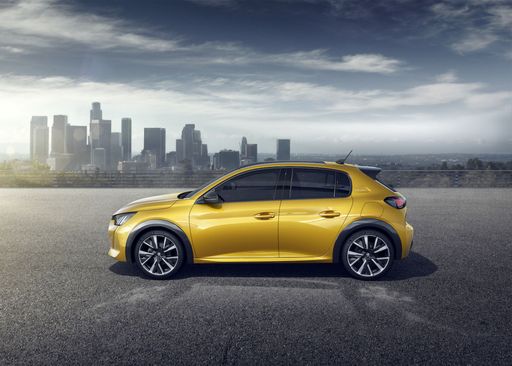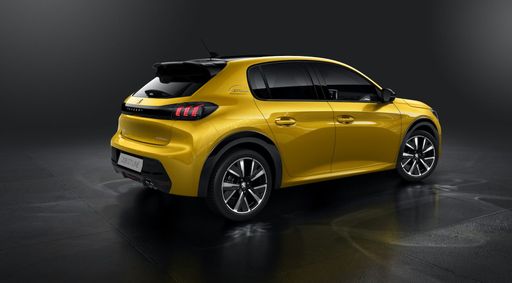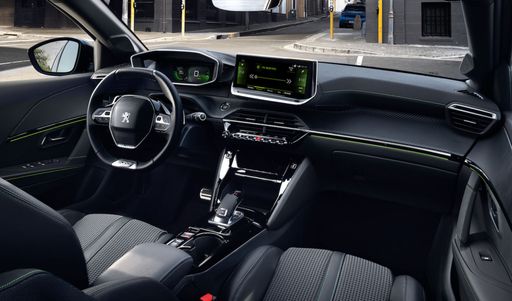Toyota Proace Max VS Peugeot 208 – Specs, Efficiency & Price Comparison
Which model is the better choice – the Toyota Proace Max or the Peugeot 208? We compare performance (279 HP vs 156 HP), boot capacity ( vs 352 L), efficiency (7.80 L vs 14.10 kWh4.50 L), and of course, the price (35500 £ vs 20200 £).
Find out now which car fits your needs better!
The Toyota Proace Max (Cargo Van) is powered by a Diesel or Electric engine and comes with a Manuel or Automatic transmission. In comparison, the Peugeot 208 (Hatchback) features a Petrol, Electric or Petrol MHEV engine and a Manuel or Automatic gearbox.
When it comes to boot capacity, the Toyota Proace Max offers , while the Peugeot 208 provides 352 L – depending on what matters most to you. If you’re looking for more power, you’ll need to decide whether the 279 HP of the Toyota Proace Max or the 156 HP of the Peugeot 208 suits your needs better.
There are also differences in efficiency: 7.80 L vs 14.10 kWh4.50 L. In terms of price, the Toyota Proace Max starts at 35500 £, while the Peugeot 208 is available from 20200 £.
Compare all the key specs now and find out which model fits your lifestyle best!
Toyota Proace Max
The Toyota Proace Max is a versatile vehicle that seamlessly combines functionality with style. Its spacious interior is designed to accommodate both passengers and cargo comfortably, making it an ideal choice for families and businesses alike. With a sleek exterior and a range of advanced features, the Proace Max stands out in its class, offering a reliable and efficient driving experience.
detailsPeugeot 208
The Peugeot 208 exudes a distinctive French charm, combining sleek lines with an assertive stance on the road. Inside, it offers a modern and sophisticated cabin, complete with intuitive technology and high-quality finishes to enhance the driving experience. Its agile handling and efficient performance make it a delightful choice for both city commuting and longer journeys.
details @ www.media.stellantis.com
@ www.media.stellantis.com
 @ www.media.stellantis.com
@ www.media.stellantis.com
 @ www.media.stellantis.com
@ www.media.stellantis.com
 @ www.media.stellantis.com
@ www.media.stellantis.com

|
|
|
|
|
Costs and Consumption |
|
|---|---|
|
Price
35500 - 61000 £
|
Price
20200 - 35100 £
|
|
Consumption L/100km
7.8 - 8.7 L
|
Consumption L/100km
4.5 - 5.2 L
|
|
Consumption kWh/100km
-
|
Consumption kWh/100km
14.1 - 15.4 kWh
|
|
Electric Range
424 km
|
Electric Range
362 - 432 km
|
|
Battery Capacity
-
|
Battery Capacity
46 - 51 kWh
|
|
co2
0 - 229 g/km
|
co2
0 - 117 g/km
|
|
Fuel tank capacity
90 L
|
Fuel tank capacity
44 L
|
Dimensions and Body |
|
|---|---|
|
Body Type
Cargo Van
|
Body Type
Hatchback
|
|
Seats
3 - 7
|
Seats
5
|
|
Doors
4 - 5
|
Doors
5
|
|
Curb weight
2075 - 2790 kg
|
Curb weight
1165 - 1530 kg
|
|
Trunk capacity
-
|
Trunk capacity
309 - 352 L
|
|
Length
5413 - 6363 mm
|
Length
4055 mm
|
|
Width
2050 mm
|
Width
1745 mm
|
|
Height
2254 - 2774 mm
|
Height
1430 mm
|
|
Payload
710 - 1460 kg
|
Payload
380 - 430 kg
|
Engine and Performance |
|
|---|---|
|
Engine Type
Diesel, Electric
|
Engine Type
Petrol, Electric, Petrol MHEV
|
|
Transmission
Manuel, Automatic
|
Transmission
Manuel, Automatic
|
|
Transmission Detail
Schaltgetriebe, Automatikgetriebe
|
Transmission Detail
Schaltgetriebe, Automat. Schaltgetriebe (Doppelkupplung)
|
|
Drive Type
Front-Wheel Drive
|
Drive Type
Front-Wheel Drive
|
|
Power HP
120 - 279 HP
|
Power HP
101 - 156 HP
|
|
Acceleration 0-100km/h
-
|
Acceleration 0-100km/h
8.3 - 10.9 s
|
|
Max Speed
130 - 161 km/h
|
Max Speed
150 - 200 km/h
|
|
Torque
320 - 450 Nm
|
Torque
205 - 270 Nm
|
|
Number of Cylinders
4
|
Number of Cylinders
3
|
|
Power kW
88 - 205 kW
|
Power kW
74 - 115 kW
|
|
Engine capacity
2184 cm3
|
Engine capacity
1199 cm3
|
General |
|
|---|---|
|
Model Year
2024 - 2025
|
Model Year
2023 - 2025
|
|
CO2 Efficiency Class
G, A
|
CO2 Efficiency Class
D, A, C
|
|
Brand
Toyota
|
Brand
Peugeot
|
Toyota Proace Max
Introducing the Toyota Proace Max: A Versatile Powerhouse
The Toyota Proace Max is a transport vehicle designed for those who need both muscle and adaptability in their daily operations. As a strong contender in the world of vans, the Proace Max impresses with a range of configurations and specifications tailored to meet commercial needs across different sectors.
Technical Excellence and Versatility
Underneath its robust exterior, the Toyota Proace Max boasts a 2.2-litre diesel engine that provides a commendable range of power outputs from 120 to 180 PS. The versatility of this van is further expanded by the choice between manual and automatic transmissions, ensuring a smooth ride no matter the conditions or preferences of the driver.
With front-wheel drive, the Proace Max delivers reliable traction and handling, even when tackling the tougher terrains. Its carbon dioxide emissions, ranging from 198 to 229 g/km, are a testament to Toyota’s ongoing commitment to balancing performance with environmental responsibility.
Innovative Design and Features
Designed with practicality and functionality in mind, the Proace Max satisfies with a payload capacity of between 1,142 kg and 1,475 kg. This, paired with its generous interior space, makes it ideal for transporting goods, equipment, or personnel.
The van offers several trim levels including Meister, Select, and with an automatic option in Meister and Comfort, all of which provide differing levels of equipment to cater for a wide range of business needs. This ensures that the Proace Max is adaptable, able to transition from a simple workhorse to a more comfortable, feature-rich transport solution with ease.
Fuel Efficiency and Environmental Considerations
The Proace Max manages an impressive fuel consumption rate between 7.5 and 8.7 L/100km, proving economical over longer distances. Its CO2 efficiency class rating of G reflects the necessity for optimum performance balanced with environmental considerations.
This balance of power and efficiency positions the Proace Max as a formidable competitor in its segment, providing a dependable and efficient solution for businesses concerned with both operational costs and environmental impact.
Spacious and Customisable Interior
Inside, the Proace Max accommodates between 2 to 6 seats, depending on the chosen configuration, making it suitable for varying needs whether for transporting crew or cargo. Its dimensions, with a length of up to 6,363 mm and height variants that reach up to 2,764 mm, ensure maximum capacity and flexibility.
For companies that require adaptable transport solutions, the Proace Max allows for significant customisation potential, ensuring the vehicle can be tailored to suit precise requirements.
Conclusion: The Ideal Workhorse
Priced between €41,472 and €64,629, the Toyota Proace Max ensures businesses can invest in a robust, innovative, and flexible transport solution without compromising on capability or efficiency. Designed to meet the demands of various commercial tasks, the Proace Max solidifies its position in the market with its innovative features, versatility, and outstanding performance.
Peugeot 208
A Glimpse into the Future: The New Peugeot 208
The Peugeot 208, with its sleek design and innovative features, continues to set benchmarks in the automotive industry. As a hatchback, it seamlessly blends style with practicality, offering the perfect solution for urban driving and long-distance travels alike. In this article, we delve into the technical details and innovations that distinguish the latest iterations of the Peugeot 208.
Engine Options: Efficiency Meets Performance
The Peugeot 208 provides an array of engine options catering to different driving preferences. Featuring both petrol Mild-Hybrid technology and full electric powertrains, it offers a versatile range designed to accommodate eco-conscious drivers as well as those who prioritise performance.
With power outputs ranging from 101 PS to 156 PS, and a torque span of 205 Nm to 270 Nm, these machines are meticulously engineered to provide thrilling yet efficient drives. The petrol versions utilise a three-cylinder 1199 cm³ engine, optimising fuel consumption between 4.7 and 5.4 L/100km, while the electric e-208 models boast an impressive range of up to 410 km on a single charge.
Advanced Transmission Systems
The Peugeot 208 models come equipped with an advanced automatic transmission system, employing either a dual-clutch automatic gearbox or a manual transmission, depending on the chosen variant. These systems guarantee smooth gear transitions, thus enhancing driving pleasure and overall efficiency.
Performance and Environmental Considerations
From a performance standpoint, the Peugeot 208 impresses with its ability to accelerate from 0 to 100 km/h in between 8.3 to 10.9 seconds, depending on the model chosen. This level of performance is complemented by a top speed ranging from 150 to 200 km/h, ensuring that the 208 is more than capable of holding its own on the motorway.
With environmental consciousness at the forefront, the vehicle's CO2 efficiency class ranges from A to D, further establishing the Peugeot 208 as a responsible option for modern drivers keen on reducing their carbon footprint.
Comfort and Practicality: A Class Act
The interior of the Peugeot 208 reflects its exterior's stylish flair. It comfortably seats five passengers and offers a boot capacity of 265 to 309 litres, accommodating both city commutes and weekend getaways. Advanced comfort features and a state-of-the-art infotainment system ensure that rides are as enjoyable for passengers as they are for the driver.
Cost Considerations
The Peugeot 208 manages to strike a remarkable balance between cost efficiency and luxury. With prices ranging from €22,950 to €40,825, there is a variant to suit most budgets while still providing a premium experience. Additionally, the monthly costs and costs per kilometre are kept in check, making it an economically sound choice in the long term.
Dimensions and Design: Compact yet Spacious
Measuring 4,055 mm in length, 1,745 mm in width, and 1,430 mm in height, the Peugeot 208 maintains a compact profile that is perfectly suited to tight urban environments. Despite its manageable size, it offers ample space inside, thanks in part to clever design and engineering.
Conclusion: A Future-Proof Choice
The Peugeot 208 is a testament to modern automotive innovation. Whether powered by traditional engines or fully electric powertrains, it consistently delivers on performance, efficiency, and style. The combination of cutting-edge technology and sustainable practices places the Peugeot 208 as a forward-thinking choice for drivers seeking a vehicle that epitomises the best of contemporary motoring.
The prices and data displayed are estimates based on German list prices and may vary by country. This information is not legally binding.
